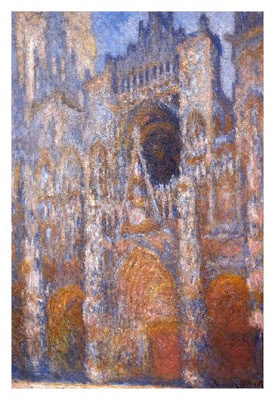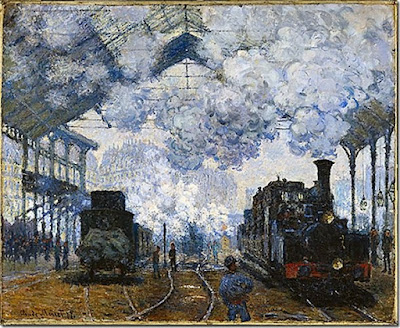 starry night, the movement is in his mind, a projection of inner turbulence (positive or negative), alive swirling, twirling)
starry night, the movement is in his mind, a projection of inner turbulence (positive or negative), alive swirling, twirling)van gogh opposite of impressionist
Review:


ss




 self portrait with grey felt hat 1853
self portrait with grey felt hat 1853

 Vincent's House (The Yellow House)
Vincent's House (The Yellow House)
 Optimism
Optimism

Review:
Georges Seurat (1859-1891): Stone Breakers at Le Raincy
Optical Mixture- Theory of complementary (opposite, complementary to what?) colors how they affect us and our vision, its creates vibration, after-image of an object will appear green virtually). an after image is always there whether we see it or not. Seurat decided to apply spots rather than full strokes (pointalism). brush strokes but very small ones. dots (the bridge at courbevoie) to capture air, which creates optical mixture in the retina as opposed to mixing pigments. sunday after on the island of la grande jatte - no lines, painting last for 2 1/2 years? impressionist worked very fast, this one was pre-mediated and worked out, there is also a gird, a structure.
 color and composition is deliberate. light isnt that important (for an impressionist). using reality as a bouncing ball. color is indicated by white lines (like a symbol, it is not a optical representation).
color and composition is deliberate. light isnt that important (for an impressionist). using reality as a bouncing ball. color is indicated by white lines (like a symbol, it is not a optical representation).
paul gauguin- tahitian woman and boy
stockbroker. he was wreckless, charismatic. he begin painting on sunday. 1884 decided to become fulltime painter. went back to an adolescent lifestyle. rented a cheap room to paint, wine, etc.
self portrait(les miserables) composition is deliberate, hard lines (bc contour lines are just an abstraction) ie: they are deemed as outcasts for stealing bread, but theyre hungry and people accused them, but they're the real deal.
At the cafe Gauguin
 color and composition is deliberate. light isnt that important (for an impressionist). using reality as a bouncing ball. color is indicated by white lines (like a symbol, it is not a optical representation).
color and composition is deliberate. light isnt that important (for an impressionist). using reality as a bouncing ball. color is indicated by white lines (like a symbol, it is not a optical representation).
Gaugin (1848) - Van Gogh painting sunflowers. He picks colors freely. He is more concerned with color composition that optical correction. He wants to paint a painting.

Gaugin (Vision after the Sermon) - Brittany woman in sunday's best. the ground indicates this is imagined, a vision. Deficiencies of city life, breaking down of faith,
the city has the presence of business, where the village does not. Business moved people away from religion.
Religious faith weakened. gauguin doubt god's existence. gaugin dreams about fighting an angel. wakes up limping.

Yellow Christ. Deliberate yellow and red. he painted in his studio.
tahiti
spirit of the dead watching (1892)

Where Do We Come from? What Are We? Where Are We Going?

no valid answer.
happiness as a concept.

potato eaters
he was dutch, van gogh was protestant work ethics were the subject of his art
weaving - you could see your progress. Expression

van gogh that of which my mind and heart is full, has to appear in my paintings
Expression
His artistic carrer comprises 5 years. He invented a style of painting driven by that which his heart and mind is filled with.
there's movement. vivid expressions
 self portrait with grey felt hat 1853
self portrait with grey felt hat 1853to express his state of mind. compositional idea. concentric circles behind his head gives depth (tis isnt against a flat surface). he doesn't represent what he sees. he projects what he feels in his mind. Impressionists records scientifically what they see.

here, he is a worker. he appreciated work. had a protestant work ethic. he appreciated people.
 Vincent's House (The Yellow House)
Vincent's House (The Yellow House) Optimism
OptimismVan Gogh did not sell his painting because his brother, the art dealer, was sensitive.
he knows something
Vincent's chair, Gaugin's chair
the cafe.

van gogh self portrait gogh spore portrét, por, van, por vor van spor gor pogh
vey.
artistic crisis, staste of culture in europe--this was very western, outsiders, islanders, maybe they have the answers. cult of primitivismisagoodthing. they studied the art of asians, africa, because these things were unsullied. used other cultures as mirrors. myth-making of other cultures. primitivismthey did this out fo need.
life has changed
art of rimbaud








